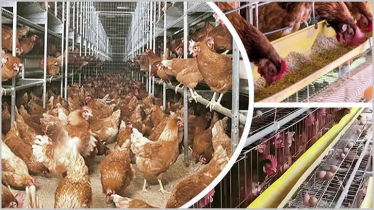
Hundreds of duck farms can be seen along both banks of the Ghorautra River in Nikli Upazila, Kishoreganj, where local ducks swim freely in temporary enclosures made from bamboo poles and nets during the monsoon. At night, they rest in small huts built on the riverbanks.
Farmers say the industry has become profitable due to low initial investment, easily available natural feed such as snails and clams, and a limited supply of commercial grains. As a result, many haor-area families are experiencing improved livelihoods.
The trend of duck farming on floating platforms is expanding rapidly not only in Nikli but also in the haor areas of Itna, Mithamain, Austagram, and Tarail Upazilas, creating employment opportunities and contributing to local economic growth.
According to local sources and the district livestock office, haor-based farms in Kishoreganj produce nearly 20 million duck eggs annually. Even after fulfilling local demand, the region supplies about 25 percent of the country’s total duck egg requirement. These eggs are transported to major cities including Dhaka, Chittagong, and Sylhet, while haor ducks’ meat is also highly popular nationwide.
In Tarail’s Damiha area, over a hundred hatcheries have emerged, producing 200,000 to 250,000 ducklings daily using traditional steaming or incubation methods. These are distributed to local farms as well as other districts across the country.
Alamgir Hossain, a duck farmer in Nikli, said, “Floating farming requires no additional land. I release ducks into bamboo and net enclosures and feed them snails and grains. Costs are low, so profits during the season are significant.”
Rabeya Khatun from Mithamain added, “Egg wholesalers take our products directly to Dhaka and Chittagong, but when ducks fall sick, we cannot access veterinary services quickly. A mobile veterinary team would reduce losses considerably.”
Shahadat Hossain, a hatchery owner in Damiha, stated, “Many hatcheries now operate here. If electricity were stable and a permanent collection center existed, operations could expand further.”
Dr. Md. Abdul Mannan, district livestock officer, emphasized, “Duck meat and eggs from haor floating farms are pure, nutritious, and highly demanded in the market. Farmers are receiving training, vaccination, and advisory support to develop this potential sector.”
Currently, Kishoreganj has about 2,000 duck farms, housing over 2.5 million ducks. Around 1,500 farmers operate these farms, and nearly 12,000 families benefit directly or indirectly from the sector. Annual egg production is approximately 20 million.
Farmers have raised concerns about delayed veterinary support during outbreaks of disease. They seek mobile veterinary services, vaccinations, medicines, low-interest loans, feed, collection centers, and fair pricing.
Experts say with increased government support and better market connectivity, floating duck farming in the haor regions could evolve from a local livelihood activity into a significant national economic sector.





